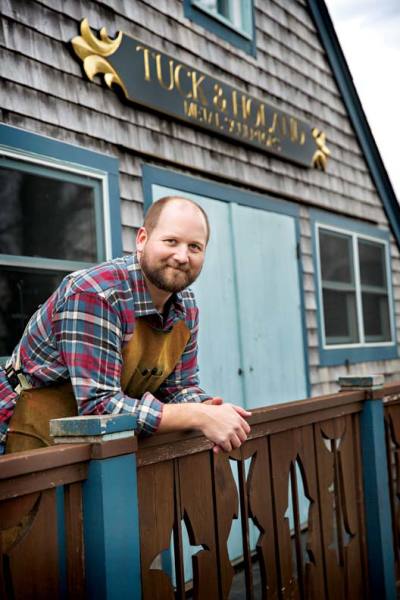
The studio, now led by Anthony Holand, was started decades ago by founder Travis Tuck.
“Our door is always open,” invites Anthony Holand. “Anyone can come by anytime to see our products and watch our process.” It’s a company policy of Tuck & Holand Metal Sculptors that’s been in place for more than 40 years of business, with the hope to rejuvenate public awareness and appreciation for the process of how things are actually made.
In Holand’s case, the “making” part involves taking raw metals such as copper, brass, stainless steel, and bronze and painstakingly molding them into custom handmade chandeliers, sundials, compass maps, and burgees (the colorful triangular flags that annotate any boat’s personal identification). Yet the most sought-after sculptures remain his one-of-a-kind weathervanes.
And sculpt he does, creating anything from the unlimited whims of imagination—like singing mermaids, dancing elephants, and racing horses with buggies—to limited-edition numbered pieces of various wildlife such as Canada geese, codfish, humpback whales, osprey, striped bass, and great white sharks, the latter of which is an ode to company founder Travis Tuck’s first creation for the fisherman character Quint (played by Robert Shaw) in the Steven Spielberg movie Jaws. Whatever the origins of the design, one thing is always guaranteed: His customers will receive a custom handmade item so exquisite that it instantly qualifies as a family heirloom.
Pursuing Interest
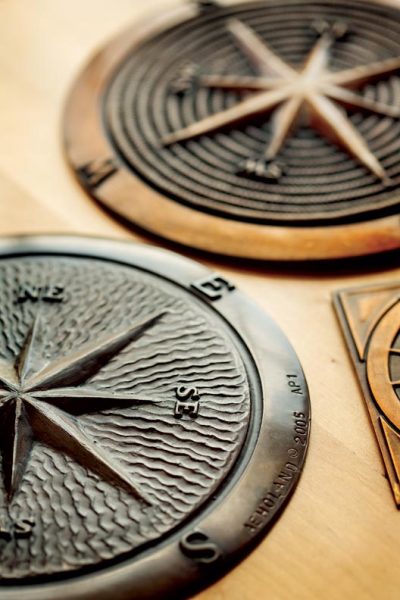
Holand’s weathervanes are works of art in metal.
Like many other young children growing up, Holand remembers playing extensively with Play-Doh and LEGO bricks. “The tangible 3-D quality was more interesting to me than drawing or painting,” he recalls. “It’s what ultimately led me to discover sculpture.” While finishing a business degree at Columbia Basin College, Holand secretly filled holes in his schedule with any sculpting classes available. “I took a class making medallions and figurines, and immediately became hooked on the lost-wax process of bronze casting,” he says. “It’s a discipline that requires a lot of patience and persistence to create a vision of art.”
With graduation quickly approaching, Holand considered returning to his family’s 6,000-acre wheat and barley farm in Washington state, where he had spent previous summers driving grain trucks and combines. That all changed when a close friend of his returned from Martha’s Vineyard with stories of how beautiful and friendly the island was. “He talked about this wonderful sense of community, where the simpler and more traditional old ways are promoted,” reports Holand. “Those values have always been very important to me, and for that reason, Martha’s Vineyard was very appealing.”
Serendipity Strikes
During Holand’s second year on the Vineyard, his employers, Bob and Linda DeLisle—owners of the bicycle shop Wheel Happy—saw an ad in the local newspaper seeking an apprentice in metal sculpting and urged him to apply. After waiting over an hour for the interview, Holand remembers quickly connecting with famed metal sculptor Travis Tuck. “Everybody on the island knew Travis,” says Holand. “He was extremely charismatic, and his work was outstanding.” To seal the deal, Holand had his parents mail some of his pieces and photo albums to Tuck to review, whereby Tuck asked Holand for a minimum two-year commitment.
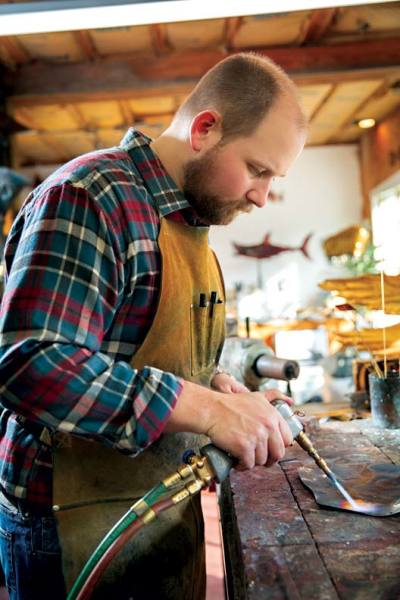
Holand forms metal at his work table.
The apprenticeship blossomed into a business partnership, and over the next five years, the two toiled side by side to expand their product line, ultimately creating more than 75 custom weathervanes for a diverse clientele: Jim Koch (of Sam Adams beer), James Taylor and Carly Simon, a second piece for Steven Spielberg, Bill and Hillary Clinton, Bloomingdale’s, the Philadelphia Zoo, and Nantucket Airport, just to name a few. Word of their capabilities secured commission for the largest freestanding weathervane in the world today: a 10′-long, 2,000-pound Nittany Lion to sit atop Penn State’s football stadium in Happy Valley, Pennsylvania. With his usual tongue-in-cheek wit, Tuck was overheard saying that “Anthony did the lion’s share of the work.”
Uncharted Waters
In the summer of 2002, Tuck fell ill and was diagnosed with mesothelioma. Less than six months later, he suddenly passed away. It was something that nobody was quite prepared for. “I had started doing more of the work because of his sickness,” recalls Holand, “but we never expected him to succumb so quickly.” The thought of taking over the business full-time was both exciting and scary. “On one hand, we had about a two-year backlog of work,” says Holand. “On the other hand,” he laments, “I had lost my mentor and my friend.”
Holand questioned his path and purpose. What emerged was his newfound identification with so many generations of other islanders who learned to etch a life on this rock in the sea. He merely pulled up his bootstraps and carried on. “I decided to focus on the work and let it speak for itself.”
Fueled by the fire to carry the studio forward, Holand set about pushing the envelope of design and quality by embellishing his products with even more dimension and detail. “The challenge is that every hammer blow changes the shape of the metal—it makes a mark that impacts the final piece, so in some ways you only have one opportunity to get it right, to make it great,” says Holand.
Fire in the Hole
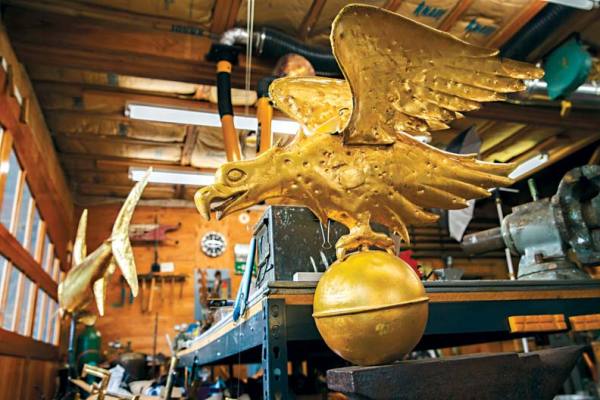
In addition to weathervanes, Holand creates other works of art out of copper, brass, stainless steel, and bronze.
He begins all collaborations by first sitting down with clients to discuss their lives, asking about work and family, in an effort to uncover personality, which ultimately contributes to the design of an item. After creating a concept on paper, Holand fine-tunes the design to ensure it is both aesthetically appealing and functionally feasible. “Ultimately, weathervanes must work with the wind,” he explains. “So we have to be sure that the design can catch and turn in the wind.”
Once the design is finalized, the paper drawing is blown up to the actual size of the entire item, then broken apart into smaller, more manageable pieces. From there, the pieces are cut out of sheets of copper, then hammered into three-dimensional sections using a process called repoussé that dates back to the mid-nineteenth century. A French word that loosely translates “to push out,” repoussé involves hitting metal, alternating between the front and back to produce a three-dimensionally sculptured section with fine details.
But before the metal can be repousséd, it must be annealed under high heat, then quickly quenched in cold water, leaving it malleable without being brittle. Over the same wooden blocks that have been used since the shop opened 40 years ago, Holand begins the hammering with a variety of rubber mallets. After fully cooling, the pieces are then welded back together by a process called brazing, whereby seams are “glued” together using a heated copper rod. In addition to the russet tones that emerge from the annealing process, Holand can choose to accent the work using gold or palladium leaf.
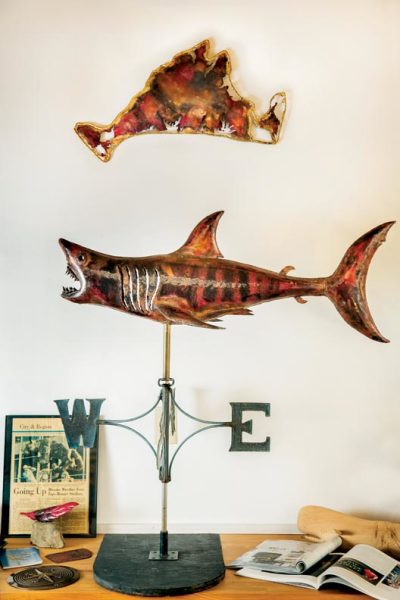
This weathervane is a replica of a shark inspired by the movie Jaws.
Blowing in the Wind
Nowadays the backlog of work is approaching a three-year waiting list—a testimony not only to Holand’s dedication and talent, but also to a diversification of the art he creates. “We’ve had quite a few repeat customers return wanting larger and more elaborate pieces,” relays Holand. “And more and more, new commissions are for artwork other than the weathervanes on which we built our reputation. Clients want me to design interior pieces in copper or bronze, such as wall or mantel pieces, door knockers, andirons, signs, and even mobiles”—the latter an homage to Alexander Calder, one of Holand’s many artistic inspirations.
Although it’s been more than 10 years since Tuck’s passing, the impact is still strongly felt by Holand. “Travis’s passion for his work and the joy he found in the relationships he formed with his clients was influential. It instilled in me an awareness of the significance I can have as an artist,” says Holand. “When I handcraft a meaningful work of art, it’s cherished by families for years to come, and offers a true appreciation for the opportunity to add to the beauty in the world.”







